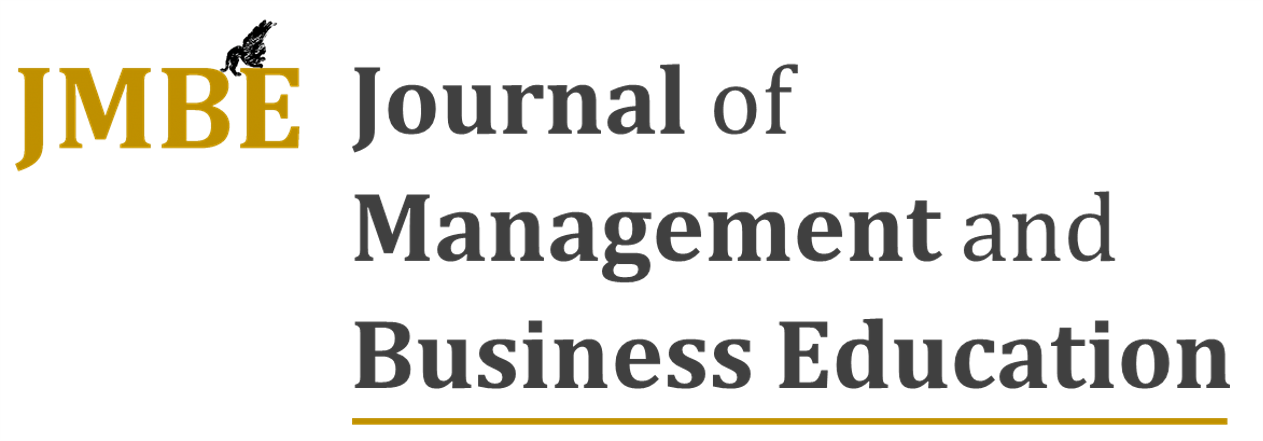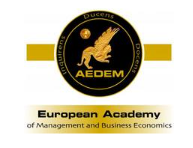Educational branding in private spanish universities: building brands that the public fall in love with
DOI:
https://doi.org/10.35564/jmbe.2020.0010Keywords:
Marketing, brand capital, higher education, private universities, Spain.Abstract
This research was carried out to examine the role of university brand capital in private Spanish universities. To this end, an empirical study was carried out with a quantitative sample of 993 valid responses from the different agents involved (343 lecturers, 164 service staff, and 486 students). The results obtained show the impact of each of the variables of brand capital at the educational level and, in particular, the importance of building brand image to maximize the perception of brand capital in private Spanish universities. At the same time, there are significant differences in perception among the different university agents involved, the service staff having the highest average in all the variables: (1) brand awareness, (2) brand image, (3) perceived quality, and (4) brand loyalty.
Downloads
References
Aaker, D. A. (1992). The value of brand equity. Journal of business strategy, Vol. 13(4), pp. 27-32.
https://doi.org/10.1108/eb039503
Abdullah, F. (2006). Measuring service quality in higher education: HEdPERF versus SERVPERF. Marketing Intelligence & Planning, Vol. 24(1), pp. 31-47.
https://doi.org/10.1108/02634500610641543
Adler, N. J.; & Harzing, A.-W. (2009). When Knowledge Wins: Transcending the Sense and Nonsense of Academic Rankings. Academy of Management Learning & Education, 8(1), 72-95.
https://doi.org/10.5465/amle.2009.37012181
Alwi, S. F. S., & Kitchen, P. J. (2014). Projecting corporate brand image and behavioral response in business schools: cognitive or affective brand attributes? Journal of Business Research, Vol. 67(11), pp. 2324-2336.
https://doi.org/10.1016/j.jbusres.2014.06.020
Asaad, Y., Melewar, T. C., Cohen, G., & Balmer, J. M. (2013). Universities and export market orientation: An exploratory study of UK post-92 universities. Marketing Intelligence & Planning.
https://doi.org/10.1108/MIP-01-2013-0007
Bagozzi, R. P., & Yi, Y. (1988). On the evaluation of structural equation models. Journal of the academy of marketing science, Vol. 16(1), pp. 74-94.
https://doi.org/10.1007/BF02723327
Berry, L. L. (2000). Cultivating service brand equity. Journal of the Academy of marketing Science, Vol. 28(1), pp. 128-137.
https://doi.org/10.1177/0092070300281012
Bok, D. (2003). Universities in the Marketplace. Princeton and Oxford: Princeton University Press.
Bosch, J., Venter, E., Han, Y., & Boshoff, C. (2006). The impact of brand identity on the perceived brand image of a merged higher education institution: Part one. Management Dynamics, Vol. 15(2), pp. 10.
Brewer, A., & Zhao, J. (2010). The impact of a pathway college on reputation and brand awareness for its affiliated university in Sydney. International Journal of Educational Management, Vol. 24(1), pp. 34-47.
https://doi.org/10.1108/09513541011013033
Brown, R. M., & Mazzarol, T. W. (2009). The importance of institutional image to student satisfaction and loyalty within higher education. Higher Education, Vol. 58(1), pp. 81-95.
https://doi.org/10.1007/s10734-008-9183-8
Browne, M. W., & Cudeck, R. (1993). Alternative ways of assessing model fit. Sage focus editions, Vol. 154, pp. 136-136.
Buil, I., Martínez, E., y De Chernatony, L. (2010). Medición del valor de marca desde un enfoque formative. Cuadernos de Gestión, pp. 10.
https://doi.org/10.5295/cdg.100204ib
Brunzel, D. L. (2007). Universities sell their brands. Journal of Product & Brand Management, Vol. 16 No. 2, pp. 152-153.
https://doi.org/10.1108/10610420710740034
Calvo, C., Levy, J. P., & Novo, I. (2013). Perceived quality in higher education: an empirical study. Marketing Intelligence & Planning, Vol. 31(6), pp. 601-619.
https://doi.org/10.1108/MIP-11-2012-0136
Carmines, E. G., & Zeller, R. A. (1979). Reliability and validity assessment, Vol. 17. Sage publications.
https://doi.org/10.4135/9781412985642
Casanoves, J. (2017). Fundamentos de Branding. Claves para construir una marca poderosa. Profit Editorial.
Casanoves, J., Küster, I, & Vila, N. (2019). Brand management in higher education: an empirical study through the agents involved. Aranzadi Editorial.
Cervera, A., Schlesinger, W., Mesta, M.A., y Sánchez, R. (2012). Medición de la imagen de la universidad y sus efectos sobre la identificación y lealtad del egresado: una aproximación desde el modelo de Beerli y Díaz (2003). Revista Española de Investigación en Marketing ESIC, Vol.16(2), pp. 7-29.
https://doi.org/10.1016/S1138-1442(14)60012-7
Chen, L. H. (2008). Internationalization or international marketing? Two frameworks for understanding international students' choice of Canadian universities. Journal of Marketing for Higher Education, Vol. 18 No. 1, pp. 1-33.
https://doi.org/10.1080/08841240802100113
Clotfelter, C. T. (2014). Buying the best: Cost escalation in elite higher education. Princeton University Press.
Conejeros, S., Leonor, M., Rojas, H., y Segure, M. (2010). Confianza: un valor necesario y ausente en la educación chilena. Perfiles educativos, Vol. 32(129), pp. 30-46.
https://doi.org/10.22201/iisue.24486167e.2010.129.18919
Cronbach, L. J. (1951). Coefficient alpha and the internal structure of tests. Psychometrika, Vol. 16(3), pp. 297-334.
https://doi.org/10.1007/BF02310555
Delgado, E., y Munuera, J. L. (2002). Medición del capital de marca con indicadores formativos. Investigación y Marketing, Vol. 759, pp.16-20.
Denegri, M., Etchebarne, M. S., Geldres, V., Cabezas, D., y Herrera, V. (2014). Personalidad de marca de las carreras de ciencias empresariales: un análisis comparativo entre universidad pública y privada. Trabajo presentado en la XLIV Asamblea Anual del Consejo Latinoamericano de Escuelas de Administración (CLADEA), Noviembre, Guayaquil.
Díaz, J. A., Alonso, A. V., y Mas, M. A. (2002). Evaluación de actitudes y creencias GIS: diferencias entre alumnos y profesores. Revista de educación, Vol. 328, pp. 355-382.
Díez, F. (2018). Dónde estamos: Una introducción a la educación en los negocios. Journal of Management and Business Education, 1(1), 1-10.
https://doi.org/10.35564/jmbe.2018.0001
Duesterhaus, A., & Duesterhaus, M. (2014). Attributes of successful university brands in the USA. Journal of brand strategy, 3(2), 169-183.
Esteban, A. A., Ballester, M. E. D., & Muñoz, J. P. (2014). ¿ Quién ama a las marcas? Determinantes personales y de consumo. Revista Española de Investigación de Marketing ESIC, 18(1), 2-16.
https://doi.org/10.1016/S1138-1442(14)60002-4
Farquhar, P. H. (1989). Managing brand equity. Marketing research, Vol. 1(3), pp. 24-33.
Faircloth, J. B., Capella, L.M., & Alford, B. L. (2001). The effect of brand attitude and brand image on brand equity. Journal of Marketing Theory and Practice, pp. 61-75.
https://doi.org/10.1080/10696679.2001.11501897
Fornell, C., & Larcker, D.F. (1981). Structural equation models with unobservable variables and measurement error: Algebra and statistics. Journal of marketing research, pp. 382-388.
https://doi.org/10.1177/002224378101800313
Furey, S., Springer, P., & Parsons, C. (2014). Positioning university as a brand: distinctions between the brand promise of Russell Group", 1994 Group, University Alliance, and Million+ universities. Journal of Marketing for Higher Education, Vol. 24(1), pp. 99-121.
https://doi.org/10.1080/08841241.2014.919980
Garcıa, M. J., & Bergantinos, G. (2001). Los componentes del valor de la marca: una aplicación empırica en el segmento alto del mercado automovilıstico. Revista Europea de Dirección y Economıa de la Empresa, 10(2), 161-78.
Gómez, D.F.H., y Medina, R.Z. (2010). Diagnóstico de la imagen de marca de las instituciones universitarias en España. En Actas-II Congreso Internacional Latina de Comunicación Social. Universidad La Laguna (España).
Hair, J.F., Black, W.C., Babin, B.J., Anderson, R.E., & Tatham, R.L. (2005). Multivariate data analysis. Upper Saddle River, NJ: Prentice Hall. Vol. 7.
Hamann, D., Williams Jr, R.L., & Omar, M. (2007). Branding strategy and consumer high-technology product. Journal of Product & Brand Management, Vol. 16(2), pp. 98-111.
https://doi.org/10.1108/10610420710739973
Hasan, H. F. A., Ilias, A., Rahman, R. A., & Razak, M. Z. A. (2009). Service quality and student satisfaction: A case study at private higher education institutions. International Business Research, Vol. 1(3), pp. 163.
https://doi.org/10.5539/ibr.v1n3p163
Hemsley, J., Melewar, T. C., Nguyen, B., & Wilson, E. J. (2016). Exploring brand identity, meaning, image, and reputation (BIMIR) in higher education: A special section, pp. 2019-3022.
Hennig, T., Langer, M. F., & Hansen, U. (2001). Modeling and managing student loyalty: An approach based on the concept of relationship quality. Journal of service research, Vol. 3(4), pp. 331-344.
https://doi.org/10.1177/109467050134006
Johnson, L., Adams Becker, S., Estrada, V., & Freeman, A. (2015). NMC Horizon Report: 2015 Higher Education Edition. Austin, Texas: The New Media Consortium.
Keller, K. L. (1993). Conceptualizing, measuring, and managing customer-based Brand equity. Journal of Marketing, Vol. 57, January, pp. 1-22.
https://doi.org/10.1177/002224299305700101
Küster, I. (2012). El Docente Universitario desde una perspectiva de mercado: Influencia en el rendimiento del estudiante. Alicante: 3 ciencias, pp. 1-118.
Martínez, J. G., Blanco, A., & Del-Castillo, C. (2019). Análisis comparado de la satisfacción de los estudiantes y docentes en la universidad pública española. Journal of Management and Business Education, 2(1), 36-47.
https://doi.org/10.35564/jmbe.2019.0005
McAlexander, J. H., Koenig, H. F., & Schouten, J. W. (2006). Building relationships of brand community in higher education: A strategic framework for university advancement. International Journal of Educational Advancement, Vol. 6(2), pp. 107-118.
https://doi.org/10.1057/palgrave.ijea.2150015
Montoya, I. A., Torres, J. A. S., Berrio, S. P. R., & Montoya, A. (2020). Lovemark effect: analysis of the differences between students and graduates in a love brand study at a public university. Innovar, 30(75), 43-56.
https://doi.org/10.15446/innovar.v30n75.83256
Mourad, M., Ennew, C., & Kortam, W. (2011). Brand equity in higher education. Marketing Intelligence & Planning, Vol. 29(4), pp. 403-420.
https://doi.org/10.1108/02634501111138563
Mourad, M. (2013). Conceptualizing brand equity in the higher education market: An exploratory study. Challenging the Bounds of Marketing Thought, pp. 263.
Ortíz, J. M., y Rúa, A. (2017). Gestión de la calidad y diseño específico de los procesos de admisión en el sistema universitario español: Estudio de caso en una universidad privada. REICE. Revista Iberoamericana sobre Calidad, Eficacia y Cambio en Educación, Vol. 15(1), pp. 87-106.
Paswan, A. K., & Ganesh, G. (2009). Higher education institutions: Satisfaction and loyalty among international students. Journal of Marketing for Higher Education, Vol. 19(1), pp. 65-84.
https://doi.org/10.1080/08841240902904869
Peltier, J. W., Schibrowsky, J. A., & Drago, W. (2007). The interdependence of the factors influencing the perceived quality of the online learning experience: A causal model. Journal of Marketing Education, Vol. 29(2), pp. 140-153.
https://doi.org/10.1177/0273475307302016
Pinar, M., Trapp, P., Girard, T., & E. Boyt, T. (2014). University brand equity: an empirical investigation of its dimensions. International Journal of Educational Management, Vol. 28(6), pp. 616-634.
https://doi.org/10.1108/IJEM-04-2013-0051
Rauschnabel, P. A., Krey, N., Babin, B. J., & Ivens, B. S. (2016). Brand management in higher education: the university brand personality scale. Journal of Business Research, 69(8), 3077-3086.
https://doi.org/10.1016/j.jbusres.2016.01.023
Retamosa, M. (2018). University Branding: capital de marca universitario desde la perspectiva de sus grupos de interés (Doctoral dissertation, Universidad de Castilla-La Mancha).
Rojas, J. I., Vasquez, A. Z., Kara, A. L. I., & Cerda, A. (2009). Determinants of student loyalty in higher education: A tested relationship approach in Latin America. Latin American Business Review, Vol. 10(1), pp. 21-39.
https://doi.org/10.1080/10978520903022089
Schlesinger, W., Cervera, A., y Calderón, H. (2014). El papel de la confianza, la imagen y los valores compartidos en la creación de valor y lealtad: aplicación a la relación egresado-universidad. Revista Española de Investigación en Marketing ESIC, Vol. 18(2), pp. 126-139.
https://doi.org/10.1016/j.reimke.2014.06.001
Sultan, P., & Yin Wong, H. (2012). Service quality in a higher education context: an integrated model. Asia Pacific Journal of Marketing and Logistics, Vol. 24(5), pp. 755-784.
https://doi.org/10.1108/13555851211278196
Sultan, P., & Yin Wong, H. (2013). Antecedents and consequences of service quality in a higher education context: a qualitative research approach. Quality assurance in education, Vol. 21(1), pp. 70-95.
https://doi.org/10.1108/09684881311293070
Sung, M., & Yang, S. U. (2008). Toward the model of university image: The influence of brand personality, external prestige, and reputation. Journal of public relations research, Vol. 20(4), pp. 357-376.
https://doi.org/10.1080/10627260802153207
Toma, J. D., Dubrow, G., & Hartley, M. (2005). The Uses of Institutional Culture: Strengthening Identification and Building Brand Equity in Higher Education. ASHE Higher Education Report. ASHE Higher Education Report, Vol. 31(2), pp. 1-105.
Voss, R., Gruber, T., & Szmigin, I. (2007). Service quality in higher education: The role of student expectations. Journal of Business Research, Vol. 60(9), pp. 949-959.
https://doi.org/10.1016/j.jbusres.2007.01.020
Williams, R. L., Williams, H. A., & Omar, M. (2013). The Marketing Impact of the Principles of Renaming Within a Higher Education Service Organization. American Marketing Association.
Yamada, G., Castro, J. F., Bacigalupo, J. L., & Velarde, L. (2013). Mayor acceso con menor calidad en la educación superior: algunas evidencias desde las habilidades de los estudiantes. Apuntes: Revista de Ciencias Sociales, 40(72), 7-32.
https://doi.org/10.21678/apuntes.72.673
Yoo, B., & Donthu, N. (2001). Developing and validating a multidimensional consumer-based brand equity scale. Journal of business research, Vol. 52(1), pp. 1-14.
Downloads
Published
How to Cite
Issue
Section
License
Copyright (c) 2023 Journal of Management and Business Education

This work is licensed under a Creative Commons Attribution-NonCommercial-ShareAlike 4.0 International License.
License terms at: https://creativecommons.org/licenses/by-nc/4.0/legalcode




